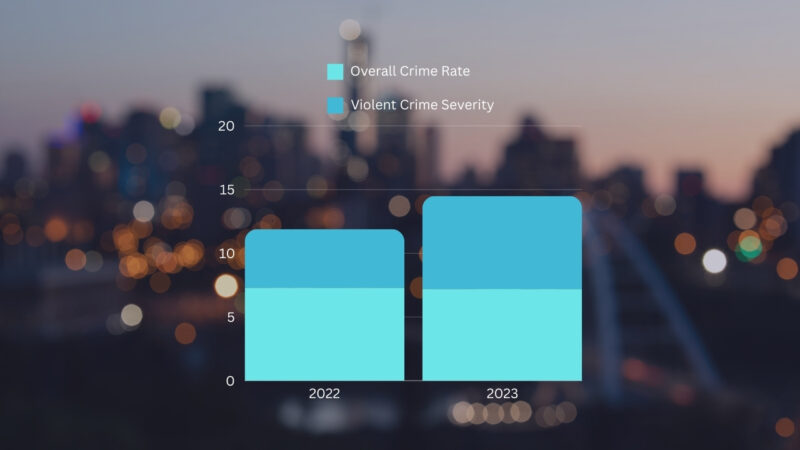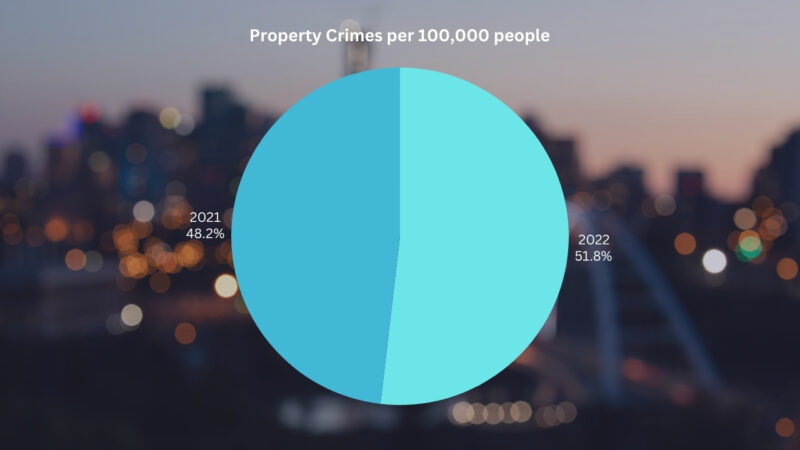The Edmonton Police Service’s 2023 crime report shows a 7.2% drop in the overall crime rate from last year, mainly due to fewer non-violent crimes. This improvement is thanks to focused policing and community safety programs.
However, violent crimes increased by 4.6% compared to 2022, highlighting ongoing challenges. This rise calls for continued efforts through initiatives like Guns and Gangs Strategy and Safer Public Spaces programs.
Table of Contents
ToggleOverview of Crime Rate in Edmonton

In 2023, Edmonton saw a significant shift in its crime landscape. The Edmonton Police Service (EPS) reported a 7.2% decrease in the overall crime rate. This decline was largely attributed to a reduction in property crimes and targeted policing efforts.
Despite the reduction in general crime, violent crime increased by 4.6%. This rise underscores the importance of EPS initiatives such as Safer Public Spaces and the Guns and Gangs Strategy.
| Crime Type | Change in Rate |
|---|---|
| Overall Crime | -7.2% |
| Violent Crime | +4.6% |
| Property Crime | Decrease |
Efforts by the EPS, including the Transit and Community Safety Teams, played a crucial role in addressing these changes. These teams focus on enhancing public safety in key areas.
Violent Crime Trends
Violent crime in Edmonton has seen a significant shift over the past year. While the city’s overall crime rate decreased by 7.2%, violent offenses have risen.
In 2023, the severity of violent crime increased by 7.3%. This includes categories such as assault, robbery, and sexual offenses.
Breakdown of Violent Crimes
- Assaults: Key contributors to the rise in violent crime.
- Robbery: Saw a noticeable uptick.
- Sexual Offenses: Increased, raising significant concerns.
Similarly, Vancouver has experienced an upward trend in its violent crime rate.
Comparative Statistics
| Year | Overall Crime Rate | Violent Crime Severity |
|---|---|---|
| 2022 | 7.3% increase | 4.6% Increase |
| 2023 | 7.2% decrease | 7.3% increase |
Specific Offense Statistics
- Assaults: Make up a considerable portion of violent crime.
- Homicides: Remained relatively stable.
Enforcement Measures
The Edmonton Police Service (EPS) has been proactive. They attribute the overall reduction in crime to targeted efforts, but the rise in violent crime indicates ongoing challenges. Continued vigilance and adjusted strategies are essential to address these issues effectively.
Property Crime Statistics
Edmonton has experienced fluctuations in property crime rates over recent years. The City of Edmonton’s Open Performance Dashboard notes a notable 14% increase in property crime from 2021 to 2022, reaching 5,057.53 incidents per 100,000 population. This figure significantly surpasses the national average of 3,314.20 incidents per 100,000 population.
Year-Over-Year Trends
- 2022: Property crimes increased by 14%
- 2021: Baseline year for comparison
The Edmonton Police Service’s 2023 Annual Report highlights a more recent improvement with a 7.2% reduction in crime rates, largely due to decreases in non-violent crimes, which include property crimes.
| Year | Property Crimes per 100,000 people |
|---|---|
| 2022 | 5,057.53 |
| 2021 | 4,697.11 |
Initiatives
The Edmonton Police Service has implemented various initiatives aimed at reducing property crime. These include the Safer Public Spaces program and the Transit and Community Safety Teams, which focus on high-crime areas.
Such efforts demonstrate how targeted measures can address and mitigate property crime trends, contributing to safer communities.
Analysis of Law Enforcement Strategies
Edmonton Police Service (EPS) has implemented several strategies to address crime effectively. The 2023-2025 Guns and Gangs Strategy focuses on collaboration with other agencies to tackle the root causes of crime. By leveraging internal expertise and forming external partnerships, this initiative aims to reduce gang activities and gun violence.
In their 2023-2026 Strategic Plan, EPS highlights significant achievements in reducing crime rates. Between 2018 and 2021, Edmonton’s total crime severity decreased by 18%. This strategy prioritizes data-driven approaches to identify crime hotspots and deploy resources effectively.
| Strategy | Description |
|---|---|
| Guns and Gangs Strategy | Focuses on reducing gang violence |
| Data-Driven Policing | Utilizes data to allocate resources |
| External Partnerships | Collaborates with social and enforcement agencies |
The largest contributor to Edmonton’s Violent Crime Severity Index (CSI) has historically been robbery. According to EPS’s 2021 Annual Report, robbery accounted for 27 points of the Violent CSI in 2021, though this was an 18.3% decrease from 2020.
To address rising crime trends, EPS also monitors national crime trends and adapts local strategies accordingly. For instance, a recent StatsCan report highlighted a nationwide increase in crime from 2021 to 2022, prompting EPS to reassess and fine-tune their tactics.
By combining targeted initiatives and adaptive strategies, EPS aims to maintain a proactive stance in crime prevention and law enforcement.
Youth Crime Dynamics
Youth Involvement
Youth are significantly involved in various types of crimes in Edmonton. According to the Edmonton Police Service, young people were responsible for a considerable percentage of the 9,000 incidents recorded.
Types of Crimes
Youth crime encompasses different types, including:
- Property crimes
- Violent crimes
A notable statistic reveals that 72% of these incidents involved property crimes, while 28% were violent crimes.
Youth Strategy Implementation
The Edmonton Police Service has implemented a Young People Strategy for 2021-2024, aiming to reduce crime and improve safety for this demographic.
Program Features
The strategy includes:
- Safer Public Spaces Initiatives
- Community Safety Teams
- Guns and Gangs Strategy
Substance-Related Incidents and Crime
Edmonton has recently observed an increase in substance-related incidents. According to Global News, Alberta experienced a notable number of toxic drug deaths, emphasizing the severity of the problem.
Toxic drug deaths have been a major concern. In 2023, over 2,500 people in British Columbia alone succumbed to toxic drug overdoses. Alberta’s statistics contribute significantly to this regional crisis.
Law enforcement confronts unique challenges. The dual task of reducing substance abuse while managing associated crimes requires comprehensive strategies.
Impacts
| Incident Type | Percentage Increase |
|---|---|
| Toxic Drug Overdoses | Significant |
| Public Substance Abuse | Increasing |
| Drug-Related Theft and Fraud | Notable |
Efforts to combat these issues include targeted policing and increased community outreach programs. The objective is to reduce both the human toll of substance abuse and its ripple effects on crime rates.

















